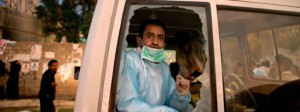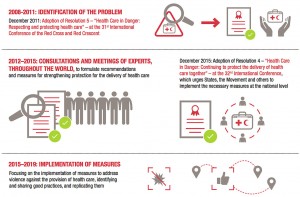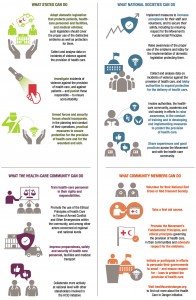The security of healthcare personnel, facilities and medical transport is of fundamental importance for the wounded and sick, both civilian and military – and for the sustainability of healthcare services as a whole during armed conflicts and other emergencies. Violence, actual or threatened, against healthcare personnel and facilities and medical vehicles can paralyse the delivery of emergency or life-saving medical assistance precisely when it is needed most.
The consequences for local communities, particularly when hospitals or first-aid posts are forced to close, are often dire. When rapid access to basic healthcare services is unavailable, chronic needs mount. The Movement has decided to address this important humanitarian challenge.
Following up on the Resolution 5 of the 31st International Conference, the Movement has mobilized its delegations and National Societies in each country, States, the health community and other actors to step up action in the field, but also to elaborate practical recommendations for ensuring the safe delivery of healthcare, and consequently to engage in their concrete implementation.
Resolution 4: Health Care in Danger: Continuing to protect the delivery of health care together was passed by consensus and constitutes a strong basis for continued cooperation between States, the RCRC Movement, international and national professional healthcare associations and healthcare providers, international and regional organizations, civil society, religious and community leaders and other relevant stakeholders to address the humanitarian consequences of violence against the wounded and sick, healthcare personnel, facilities and medical transports in armed conflicts or other emergencies, especially at a national level.
Additionally, many conference participants, including States, National Societies, ICRC and health care organizations seized the opportunity to submit pledges. The focus of these pledges includes: strengthening the national regulatory framework; training health care personnel on ethical principles; safer access for Red Cross Red Crescent staff and volunteers; increasing respect for the emblems and raising awareness about rights and responsibilities of health care personnel; establishing a mechanism for monitoring violence against health care; developing context specific tools to improve delivery of health care; working with academia to include Health Care in Danger messages in curricula; training armed and security force on rights & responsibilities of health care personnel and ethical principles; and measures to improve safety of health care facilities.
Health Care in Danger from 2008 to 2015: a timeline
The 32nd International Conference identified a number of actions to take in the next four years, some of them are listed below:




